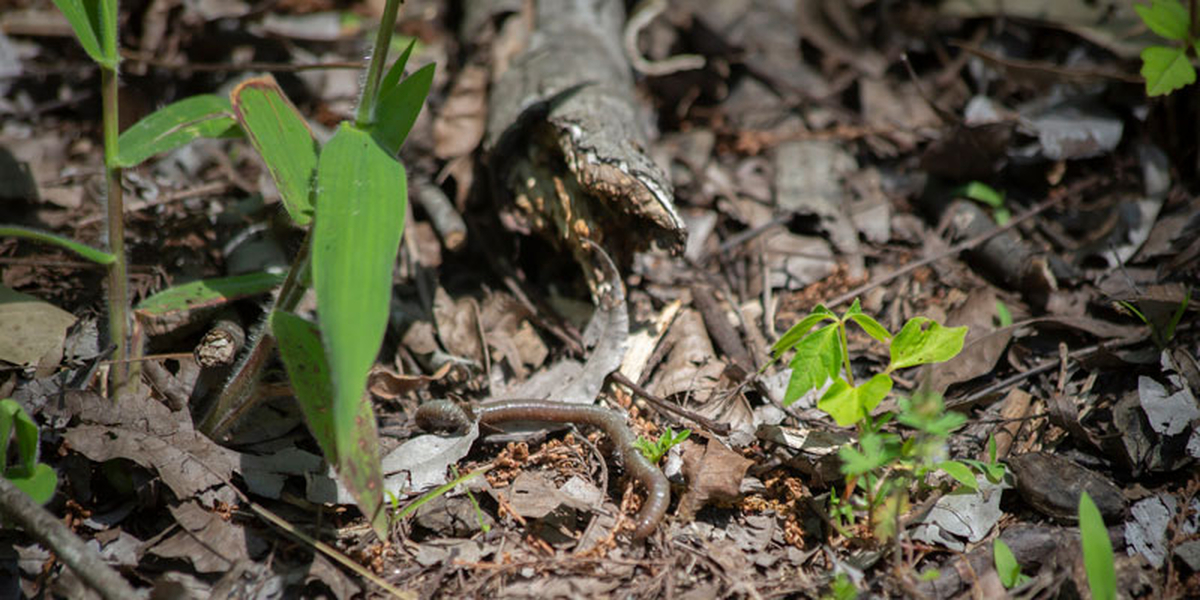
The team loads up the bags of dried mustard in the car. Next stop: northwest Minnesota. It may sound like a restaurant delivery, but the condiment’s final stop won’t be a diner booth.
Kyungsoo Yoo, a professor in the University of Minnesota’s Department of Soil, Water, and Climate, predicts that the lab goes through more dried mustard than any restaurant establishment in the Twin Cities. In fact, dried mustard is a critical part of their research operations.
An ongoing research project in the Yoo lab —with roots just miles away from Itasca Biological Station and Laboratories (IBSL)— focuses on subterranean species with an aversion to mustard. “If you pour a mustard solution on the ground, earthworms will wiggle up from below,” says Sara DeLaurentis, a graduate student in the Yoo lab.
Despite their prevalence on the Minnesota landscape, earthworms aren’t native. When glaciers receded from Minnesota around 10,000 years ago, plants and soil fauna returned, sans earthworms. Without earthworms, leaf litter slowly accumulates and piles up in a mulch layer at least several centimeters thick. This mulch layer insulates the soil below from temperature swings at the surface. “We’re interested in how the arrival of earthworms impacts the temperature at the soil surface and at different soil depths,” says DeLaurentis.
Earthworms bring about big changes to forest soils. They burrow, consume organic matter and poop. By doing so, they churn up the soil contents and accelerate decomposition. The majority of research up to this point focused on deciduous forests, comprised of broadleaf oaks, maples and other trees that drop nutrient-rich leaves every fall. Evidence points to faster nutrient cycling and thinner leaf carpets in deciduous forests with earthworms.
Coniferous forests, characterized by their needles and acidic soils, have received less attention. Gaining a better understanding of how earthworms impact coniferous forests is important as they account for about a third of the forests in the world. With the support of an IBSL Seed-to-Root Grant, research got underway in 2019 at the intersection of deciduous and coniferous forests around Itasca State Park.
Digging in
To study the impact of earthworms, researchers first needed to find areas devoid of them. Researchers donned jackets made of bug nets to shield themselves from pesky coworkers (mosquitoes), gathered gallons of mustard solution and headed into the woods.
Despite Itasca’s distance from a major urban area, European earthworms thrive there. In part, it’s due to their prominence at the end of a fishing line. “We’ve had a hard time finding places in Minnesota that don’t have earthworms. From neighborhood parks to remote portages in the Boundary Waters Canoe Area, they’re everywhere,” says Yoo.

Once they found sites with lower densities of earthworms in coniferous and deciduous woods, the manual work began. DeLaurentis and her team dug two dozen knee-deep pits, working around tree roots and unearthing rocks, and then buried button-sized devices that track temperature. She refilled the pits and then watched the temperature data synch. Over the next year and a half, the sensors tracked temperature every four hours.
Researchers were surprised to find that earthworms set up shop in both forest types at comparable densities. Areas with few earthworms have a thicker leaf carpet, which serves as insulation from both cold and hot temperatures.
“In heavily infested sites, the soil temperatures in mid-summer were roasting in comparison to their earthworm-free counterparts. In the winter with that insulating layer removed, that soil froze,” says Yoo. Earthworm invasions in combination with rising temperatures due to climate change mean that dramatic temperature fluctuations are on the horizon. Gaining a better sense of how that impacts soil carbon pools locally and across the globe is top of mind for many soil scientists.
Jumping off
Digging holes and logging temperature data didn’t stop at Itasca. Neither have the European earthworms. Researchers recently collected the temperature sensors after more than a year underground from sites in Alaska and Sweden. Yoo, DeLaurentis and colleagues, including Lee Frelich, the director of the Center for Forest Ecology and Xue Feng, an assistant professor in the College of Science and Engineering, are in the process of analyzing data to sort out whether earthworms impact soil temperatures in the forests in Minnesota and beyond.
Recently, an invasive worm from Asia known as the jumping worm is making itself home in Minnesota. “It’s quite plausible that jumping worms will replace European earthworms in Minnesota, the arctic and beyond. We want to know how that will impact soil temperatures,” says Yoo.
Given the pervasive wiggle of earthworms across the globe, finding answers to these questions will be an important puzzle piece in making accurate predictions about soil carbon in the years to come. —Claire Wilson
About the article | This article originally appeared in the Spring 2022 edition of Upstream, a biannual publication by Itasca Biological Station and Laboratories.